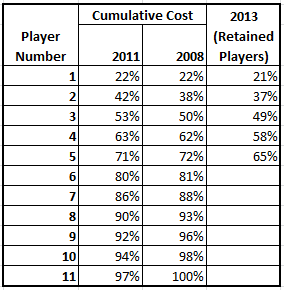So we are halfway through what is easily the most competitive English Premier League in recent times. To illustrate, Liverpool were on top of the table at Christmas, and after two successive defeats, lie fifth at the New Year. Anything can happen this season and the top seven or eight teams are all still in contention.
One interesting factor this season, however, has been the fixture list. For example, only Manchester United among the top eight has played at Anfield (Liverpool’s home ground) this season. Liverpool has played every other top eight team away so far – which means they will face them all at home in the second half of the season.
On the other hand, Manchester City has hosted all top eight teams bar Chelsea so far! Which means they will be playing all these teams away this season! Sunderland is currently bottom. However, they have hosted mostly top-half teams (which are significantly superior to them) and played away to other bottom half teams which are of comparable strength.
The following table illustrates who has hosted whom. The table is to be read row-wise. “H” and a red cell means that the team in the corresponding row has hosted the team in the corresponding column. A while cell and “A” implies otherwise.Notice that this is the only point of time in the season when we can do this analysis for now everyone has played everyone else exactly once. Teams in this table are ordered in descending order of points.

Can we have a metric of who has had the best set of home fixtures this season so far? For this, let us define a “home index”. For each team, this is calculated as the difference between the average points of the teams played at home and the average points of the teams played away.
Let me illustrate. Arsenal, for example have so far hosted Chelsea, Everton, Liverpool, Spurs, Southampton, Hull, Stoke, Villa and Norwich. These teams have an average of 28.6 points as of now. Arsenal has so far visited the rest of the clubs, viz. Manchester City, Manchester United, Newcastle, Swansea, Cardiff, West Brom, Crystal Palace, Fulham, West Ham and Sunderland. These teams average 22.6 points as of now. So Arsenal’s home index is 28.6 – 22.6 = 6.0
A positive home index implies a team has played more strong teams at home and weak teams away. It is not easy to say, however, whether this implies an easier second half of the season. Arsenal, for example, would be happy to host the weaker teams they have traveled to, but the fixture list means they will be traveling to more strong teams, which means the potential for dropping points is higher.
Among the relegation-threatened teams, Sunderland has the highest “home index”, and for them the season is likely to become better – in the second half, they will get to host the weaker teams whom they can reasonably expect to beat while traveling to stronger teams (who they’ve lost to anyway) won’t change much. Thus, a high home index is a positive for lower-ranked clubs.
The following graph shows the home-away index for all clubs:
 Notice that both Arsenal and Manchester City have had an easier run so far – hosting the better teams. it will be interesting to see how they perform in the second half of the season when they travel to the better clubs. Especially given that Liverpool and Chelsea have had a bad run of fixtures in the first half and are likely to improve in the second half.
Notice that both Arsenal and Manchester City have had an easier run so far – hosting the better teams. it will be interesting to see how they perform in the second half of the season when they travel to the better clubs. Especially given that Liverpool and Chelsea have had a bad run of fixtures in the first half and are likely to improve in the second half.
Finally, the first part of the post assumes that teams are better off playing at home rather than away. Is this really true? To check this, let us look at the average points scored by teams in home and away games. This number should be taken with a pinch of salt, though – teams with a high home index are less likely to perform significantly better at home compared to away.
Based on the performance so far, the average points in home games is 0.28 more than the average points in an away game. However, we also need to take into account the home index. When we regress the difference between home and away points against the home index, we find that for every one point higher in home index, the difference between home and away performance comes down by 0.04 (the R-square, for those that are interested in such things, is 15%).
The following table shows the difference in home and away performances of different teams:
 Most teams, you can see from this table, have done better home than away. The significant exceptions are Aston Villa, Manchester United and Spurs. Villa and Manchester United have a high Home Index which possibly explains this. There is no explanation of spurs’ home form, though.
Most teams, you can see from this table, have done better home than away. The significant exceptions are Aston Villa, Manchester United and Spurs. Villa and Manchester United have a high Home Index which possibly explains this. There is no explanation of spurs’ home form, though.







